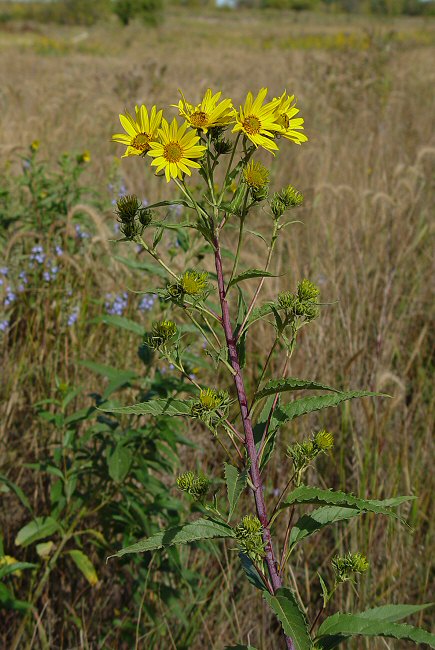Helianthus grosseserratus M. Martens
Sawtooth Sunflower

Native
CC = 4
CW = 0
MOC = 54
© DETenaglia
Helianthus grosseserratus M. MartensSawtooth Sunflower | |
 |
Native CC = 4 CW = 0 MOC = 54 |
© DETenaglia |
|
Family - Asteraceae/Heliantheae Habit - Perennial forb with short-creeping or sometimes longer, thick, branched rhizomes, sometimes occurring in dense colonies.
Stems - Erect, to 3 m, stout, often appearing somewhat clumped, usually glaucous, glabrous below the midpoint, often sparsely to moderately pubescent with short, ascending hairs toward the tip.
Leaves - Alternate, sometimes opposite on the lower stems, simple, petiolate, relatively numerous and well developed along the stem (usually with 20-25 nodes). Blades of the stem leaves 5-30 cm long, 1-9 cm wide, usually arching, narrowly lanceolate to narrowly ovate, flat or shallowly folded, tapered at the base, tapered to a sharply pointed tip, the margins finely to coarsely and sharply toothed, flat, the upper surface sparsely to moderately pubescent with minute, broad-based hairs, usually not or only slightly roughened to the touch, the undersurface densely pubescent with minute, soft, appressed hairs, both surfaces also with sparse to moderate, sessile, yellow glands, more or less with 1 main vein but the lowermost pair of lateral veins usually slightly more prominent than the other pinnate lateral veins. Venation expressed abaxially.
Inflorescences - Solitary terminal heads to very large, open panicles of heads. Peduncles antrorse-pubescent, typically with one or two linear bracts.
Heads - Radiate, showy. Involucre 10-15 mm long, 15-25 mm in diameter, the bracts in 2 or 3 subequal series, narrowly lanceolate to nearly linear, tapered to a sharply pointed, slender, loosely ascending to more commonly spreading or recurved tip, the margins with short hairs, at least toward the base, the outer surface glabrous or sparsely hairy toward the base but usually lacking glands. Receptacle convex, the chaffy bracts 7-9 mm long, narrowly oblong-triangular to nearly linear, angled or short-tapered to a sharply pointed, green, minutely hairy tip, the outer surface also minutely hairy. Disk to 1.5 cm broad.
Flowers - Ray florets sterile, 10-25 per head, the corolla 2.0-4.5 cm long, yellow, glabrous. Disc florets numerous, perfect, with the corolla 5-6 mm long, yellow throughout. Pappus of 2 scales 2.0-2.5 mm long, these narrowly triangular, tapered abruptly to a sharply pointed, often minutely awnlike tip. Disk stamens 5, adnate at the apex of the constricted portion of the corolla tube. Filaments compressed, pale yellow, 3-4 mm long. Anthers dark purple-brown, 2.5 mm long, exserted, connate around style. Style exserted beyond the anthers, bifurcate, pale basally, yellow apically, glabrous, divided for about 2 mm.
Fruits - Achenes 3-4 mm long, narrowly wedge-shaped, flattened but more or less 4-angled in cross-section, the surface glabrous, often finely mottled with dark brown to nearly black and lighter brown patches.
Flowering - July - October. Habitat - Prairies, bases of bluffs, streambanks, fens, pond margins, ditches, fields, pastures, railroads, roadsides, open disturbed areas. Origin - Native to the U.S. Lookalikes - Other species of Helianthus, most notably H. tuberosus and H. maximiliani; also Heliopsis helianthoides. Other info. - This showy species can be found throughout much of Missouri but is apparently absent from most of the southeastern third of the state. Its larger range mainly occupies the upper U.S. Midwest, with more scattered populations elsewhere. The plant is easy to ID in the field because of its relatively long, slightly folded leaves and its smooth, usually glaucous stems. No other species of sunflower in Missouri has this combination of leaf shape and (lack of) stem pubescence. Under optimal conditions the plant will get very large and bear a dozen or more showy flowering heads. The "seeds" (actually fruits) resemble the oil sunflower seeds often sold as bird seed. These are produced by closely related plants. Photographs taken outside of Salem, MO. off Hwy 68, 9-18-03, and at Tall Grass Prairie, KS., 9-23-06 (DETenaglia); also at Busch Wildlife Area, St. Charles County, MO, 9-4-2009 and 10-14-2020, Shaw Nature Reserve, Franklin County, MO, 8/20/2011, 10/3/2011, and 9-26-2018, and at B. K. Leach Memorial Conservation Area, Lincoln County, MO, 9-13-2021 (SRTurner). |